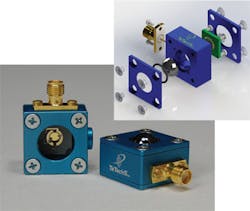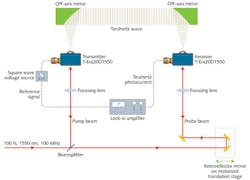TERAHERTZ SOURCES: Terahertz emitters gain power, variety
DARYOOSH SAEEDKIA
The advance of terahertz technology in photonics, electronics, and communications has entered a new realm. Today's transistors function at teraflops per second, wireless data communication is reaching to terabit-per-second speed, and terabyte hard-drive memories are now a reality.
Over the past two decades, intense research and development in photonics, both in academia and industry, has closed the terahertz gap between the microwave and infrared (IR) spectra. Compact terahertz sources and detectors have been developed to generate, detect, and manipulate coherent terahertz signals. Terahertz sensing and imaging systems are now commercially available, and terahertz wireless communications is on the foreseeable horizon.
Recent innovations offering powerful and reliable terahertz sources have exposed new opportunities in science and technology. Although major gains in performance and functionality are still anticipated, present commercially available terahertz sources have already made the terahertz spectrum accessible to many scientists and technologists in diverse areas, ranging from biology and medicine to chemical, pharmaceutical, and environmental sciences, enabling them to revisit their scientific problems under the light of terahertz waves.
Over the past few years, progress in the area of terahertz source technologies has played an important role in opening up the possibility of using terahertz radiation in many real-world applications. Terahertz photoconductive antennas have seen a great improvement in their performances in terms of optical-to-electrical efficiencies and maximum output powers at frequencies above 1 THz. New material systems have been developed for terahertz photoconductive antennas, allowing them to operate at optical telecommunication wavelengths. Taking advantage of low-cost laser diodes and high-power fiber amplifiers and other optical telecommunication components, it is now possible to significantly reduce the cost of terahertz systems.
Miniaturized electron-beam sources have been developed and the performance of solid-state sources and frequency multipliers has been steadily improved by increasing their upper frequency limits and power efficiencies. Terahertz quantum-cascade lasers (QCLs) have experienced a rapid improvement over the last few years. Their output power level and operation temperatures have been increasing, whereas their lowest operation frequencies have been continuously decreasing.
Terahertz sources can be divided into two major categories: electronic and photonic sources. Electron-beam and solid-state sources as well as frequency multipliers are widely used terahertz electronic sources. Terahertz photoconductive antennas and terahertz QCLs are the most common terahertz photonic sources.
Terahertz photoconductive antennas
Laser-driven terahertz photoconductive antennas (THz-PCAs), which are coherent terahertz sources, are among the most promising candidates for developing compact, portable, low-power-consuming, rugged, and low-cost spectroscopy and imaging systems for various terahertz applications. An antenna-coupled THz-PCA consists of a planar metallic antenna structure connected to a pattern of closely spaced metallic electrodes, which are printed on a layer of ultrafast photoconductive material located at the feeding point of the antenna. The generated terahertz signal is coupled to the antenna structure, which efficiently radiates the terahertz wave into free space. Resonant structures such as slot and dipole antennas have relatively higher radiation efficiencies. However, for wideband applications, bow-tie antennas or self-complementary spiral antennas are more appropriate.
The typical optical-to-electrical conversion efficiency for conventional antenna-coupled THz-PCAs—defined as the ratio of total terahertz power to total incident optical power—is below 10-5 for a single device. The maximum available terahertz power from a single THz-PCA device is limited by its maximum sustainable optical power and DC bias before device failure. The total sustainable optical power for a THz-PCA made of low-temperature-grown gallium arsenide (LT-GaAs) working at room temperature when biased at 4 V/μm is about 0.9 mW/μm2.1 The maximum sustainable optical power can be increased by transferring the LT-GaAs film to a higher-thermal-conductivity substrate such as silicon or diamond, or by growing a heat-spreading epilayer such as aluminum arsenide (AlAs) beneath the LT-GaAs film.2Low-temperature-grown GaAs has been widely used as the ultrafast photoconductor in THz-PCAs operating in the 800 nm wavelength range, owing to its subpicosecond carrier lifetime, high electric breakdown field, and relatively high carrier mobility. THz-PCAs have been successfully developed using other material systems, such as low-temperature-grown indium gallium arsenide (In0.3Ga0.7As) lattice-mismatched on a GaAs semi-insulated substrate for use at wavelengths around 1000 nm, and beryllium (Be) doped low-temperature-grown lattice-matched In0.53Ga0.47As–In0.52Al0.48As multi-quantum wells on an indium phosphide (InP) semi-insulated substrate for operation at 1550 nm.3
The latter material system is a breakthrough in developing suitable photoconductive materials for THz-PCAs operating at telecommunication wavelengths. It opens up new opportunities to develop all-fiber rugged terahertz sensor systems that can be deployed in an industrial setting with the capability of real-time sensing and imaging. THz-PCA technologies based on new In0.53Ga0.47As–In0.52Al0.48As multi-quantum-well material systems take advantage of an all-optical-fiber laser-light delivery system in a compact and regularized system architecture.
In the continuous-wave (CW) operation mode of a THz-PCA, two CW laser beams with a frequency difference in the terahertz range, combined either inside an optical fiber or properly overlapped in space, are mixed in a photo-absorbing medium and generate a beat-frequency signal. Terahertz signals with a frequency linewidth as low as a few kilohertz can be generated by THz-PCAs. The frequency of the terahertz signal can be tuned by tuning the wavelengths of the lasers. The output power in conventional THz-PCAs falls from about 2 μW at 1 THz to below 0.1 μW at 3 THz.
More terahertz photonic sources
Quantum-cascade lasers are the most promising terahertz semiconductor lasers. A QCL is a unipolar laser in which the conduction band or the valence band is divided into few sub-bands. The carrier transition occurs between the discrete energy levels within the same band. The discrete energy levels are created in a semiconductor heterostructure containing several coupled quantum wells. QCLs with an output of 10 mW at 2 THz have been demonstrated. An operation temperature as high as 93 K has been reported for a terahertz QCL emitting at 3.2 THz.4
Terahertz signals can be generated via parametric interaction of near-IR photons and optical vibration modes inside an optical crystal. Generation of a quasi-CW terahertz signal with pulse duration of 3.6 ns, an average power of 9 nW, and a frequency-tuning range of 0.7 to 2.4 THz has been reported.5
Terahertz signals can also be generated through difference-frequency mixing in nonlinear crystals. Mixing a dual-wavelength ytterbium (Yb) fiber laser with pulse duration of 1 ns in a zinc germanium diphosphide (ZnGeP2) crystal, 2 mW average terahertz power was generated at 2.45 THz.6
Terahertz electronic sources
Gyrotrons, free-electron lasers, and backward-wave oscillators are the most widely used electron-beam sources. Their operation is based on the interaction of a high-energy electron beam with a strong magnetic field inside resonant cavities or waveguides, which results in an energy transfer between the electron beam and an electromagnetic wave. Gyrotrons with 1 MW power at 140 GHz have been successfully developed.7 Backward-wave oscillators can generate up to 50 mW of power at 300 GHz, dropping to a few milliwatts at 1 THz.8
Among solid-state sources, Gunn devices that generate a few microwatts of power in a 400-560 GHz frequency range are feasible. Tunnel-injection transit-time (TUNNETT) diodes with operation frequencies as high as 355 GHz and 140 μW output power have been reported.9
In a terahertz frequency multiplier, the frequency of a driver source is multiplied in a nonlinear device to generate higher-order harmonic frequencies. Planar-Schottky varactor diodes are commonly used in frequency multipliers, taking the advantage of GaAs substrateless technology to reduce substrate loss. The most efficient terahertz frequency multipliers comprise series chains of frequency doublers and frequency triplers. Signals up to 2 THz are achievable from frequency multipliers.10
A major roadblocks to mass-market adoption of terahertz systems is the high ownership cost. Existing commercial terahertz imaging systems carry six-figure price tags, making them too expensive for the consumer market and for many industrial applications. Advancement in CMOS-based terahertz sources generating terahertz signals on an inexpensive silicon chip could lead to compact and low-cost terahertz imaging systems.11, 12
Terahertz time-domain systems
Broadband terahertz pulses can be generated by exciting a THz-PCA with an ultrafast laser. Using a femtosecond laser with 100 fs optical pulse duration and a few hundred milliwatts average power, terahertz pulses with frequency content extended up to around 5 THz and an average power of a few microwatts can be achieved. A THz-PCA driven by a femtosecond laser beam can also be used to detect a broadband terahertz pulse with frequency content extending beyond 5 THz.
Terahertz time-domain systems using THz-PCAs driven by femtosecond short-pulse lasers are commercially available and have been deployed for industrial applications in material sensing and quality control. By using a room-temperature coherent time-gating detection technique, terahertz time-domain systems provide larger signal-to-noise ratio and dynamic range compared to other room-temperature terahertz imaging and sensing approaches.
REFERENCES
1. S. Verghese et al., Appl. Phys. Lett., 71, 19, 2743 (1997).
2. T. Ackemann et al., J.Appl. Phys., 112, 12, 123109 (2012).
3. M. Missous et al., IEEE Sensors Journal, 13, 1, 63 (2013).
4. S. Kumar et al., Appl. Phys. Lett., 84, 14, 2494 (2004).
5. K. Kawase et al., J. Phys. D, Appl. Phys., 34, R1 (2001).
6. D. Creeden et al., IEEE J. Sel. Topics Quantum Electron., 13, 3, 732 (2007).
7. G. Dammertz et al., IEEE Trans. Plasma Sci., 30, 3, 808 (2002).
8. L.P. Schmidt et al., "THz measurement technologies and applications," Proc. 14th Int. Conf. Microwaves, Radar, and Wireless Commun., 2, 581 (2002).
9. H. Eisele, Electron. Lett., 41, 6, 55 (2005).
10. J. Ward et al., "Capability of THz sources based on Schottky diode frequency multiplier chains," Proc. IEEE Microwave Theory and Techniques Soc. Int. Microwave Symp. Dig., 3, 1587 (2004).
11. Y.M. Tousi et al., IEEE J. Solid-State Circuits, 47, 12, 3032 (2012).
12. K. Sengupta and A. Hajimiri, IEEE J. Solid-State Circuits, 47, 12, 3013 (2012).
Daryoosh Saeedkia is president and CEO of TeTechS, 295 Hagey Blvd, 1st Floor, Waterloo, ON N2L 6R5 Canada; e-mail: [email protected]; www.tetechs.com.

